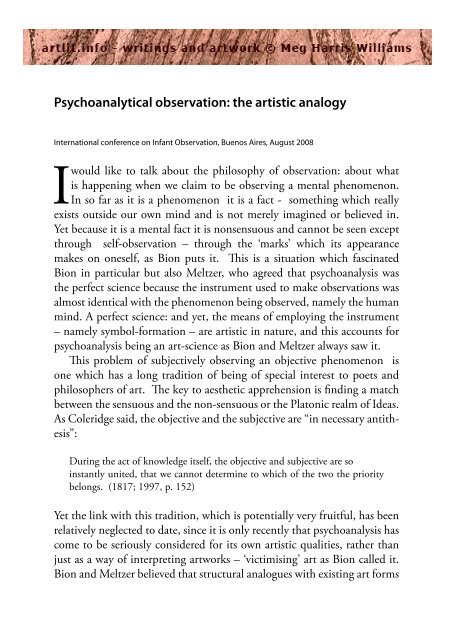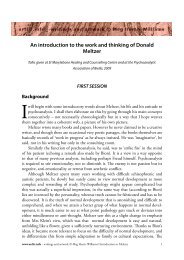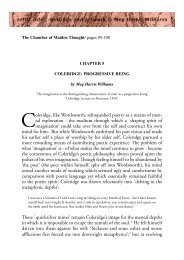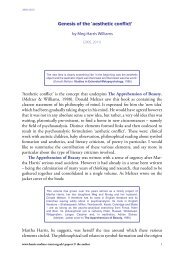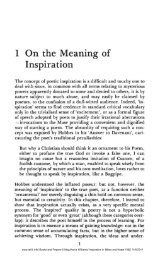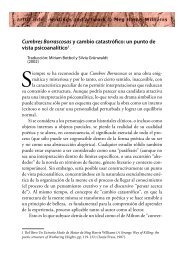Psychoanalytical observation: the artistic analogy - Artlit
Psychoanalytical observation: the artistic analogy - Artlit
Psychoanalytical observation: the artistic analogy - Artlit
You also want an ePaper? Increase the reach of your titles
YUMPU automatically turns print PDFs into web optimized ePapers that Google loves.
A dream-reader is by definition a type of artist, or symbol-maker: someonewho “can intuit <strong>the</strong> significant potential of a form” (Langer 1942, p.223; 1953, p. 390). Reading <strong>the</strong> dream – of whatever kind – is a far morecomplex process than merely interpreting it. Looking, reading, and listening,are complex processes that entail abandoning <strong>the</strong> personal intellectual“possessions” of memory and desire (Bion 1970, p. 43) in order to achievea more accurate picture of in <strong>the</strong> feeling-present.‘Reading’ is one of those terms that Bion adjures us to consider morecarefully, like ‘experience’ or ‘thinking’ or ‘knowing’, in order to restore itsvalue:It is as well to be reminded by <strong>the</strong> poet Herman Melville that <strong>the</strong>re are manyways of reading books, but very few of reading <strong>the</strong>m properly – that is, withawe. How much <strong>the</strong> same is it true of reading people. (Bion 1985, p. 241)How do we ‘read’ books, people, paintings, music, ‘with awe’? that is ina way that involves being internally affected by <strong>the</strong> aes<strong>the</strong>tic object beyondour control, as Meltzer puts it, or that entails an intersection with O, <strong>the</strong>Platonic realm of unknown ideas, as Bion puts it.A special type of identification with <strong>the</strong> aes<strong>the</strong>tic object is required inorder to ‘read’ <strong>the</strong> impact on one’s own mind. It is a problem that applieswith equivalent force to <strong>the</strong> situation of <strong>the</strong> analyst, or <strong>the</strong> poetry-reader,or <strong>the</strong> baby-observer. In <strong>the</strong> field of art criticism Adrian Stokes <strong>the</strong> artcritic explains how, in our close viewing of art, we find ourselves “in touchwith a process that seems to be happening on our looking, a process towhich we are joined as if to an alternation of part-objects” (1965, p. 26).He described this projective-introjective dialogue as “envelopment andincorporation”. The projective movements are communicative, questingones, not omnipotent ones designed to control <strong>the</strong> object. In this way wecome to hold <strong>the</strong> feel of a dream that would “o<strong>the</strong>rwise be forgotten”. Aswe observe <strong>the</strong> dream, a container forms to hold our <strong>observation</strong>s, providedwe maintain our orientation to <strong>the</strong> aes<strong>the</strong>tic object. As Bion puts it,we identify with O – not with ei<strong>the</strong>r mouth or breast alone but with <strong>the</strong>link between <strong>the</strong>m that points to O and makes contact with <strong>the</strong> underlyingIdea of <strong>the</strong> situation.Bion sees this container as forming within a space that is created byscientific, <strong>artistic</strong> and religious vertices operating in unison, provided <strong>the</strong>www.artlit.info - writings and artwork © Meg Harris Williams/ Psychoanalytic <strong>observation</strong> 3
tension between <strong>the</strong>m is nei<strong>the</strong>r too loose nor too slack. ‘But first’, saysBion, ‘we have to look – and most people don’t – and while looking, recognize<strong>the</strong> meaning which lies beyond’ (2005, pp. 64-5). Meltzer, also, says‘The foundation of Truthfulness lies in <strong>the</strong> quality of <strong>observation</strong>’ (1988,p. 203). Observation cannot take place (he continues) without an existingexplicit model in <strong>the</strong> back of one’s mind, for without this <strong>the</strong> unknowncannot emerge into awareness and <strong>the</strong> model be extended (p. 204). This isdifferent from applying an interpretation. He describes a space that ‘scintillateswith potentiated meaning’ (1983, p. 148). We can say that thisscintillating space is <strong>the</strong> space in which <strong>the</strong> symbol of <strong>the</strong> emotional experienceis formed, and it is governed by <strong>the</strong>se three ways of knowing- scientific,<strong>artistic</strong> and religious. The symbol comes into being as a result ofhigh-quality <strong>observation</strong>; and in this way psychoanalysis joins o<strong>the</strong>r modesof imaginative inquiry - both scientific and <strong>artistic</strong> – that are founded onlearning to look and listen more carefully, and that can tolerate <strong>the</strong> aweof <strong>the</strong> unknown that is at <strong>the</strong> heart of any live experience – <strong>the</strong> aes<strong>the</strong>ticconflict.Art-symbols, Langer explains, come into being through <strong>the</strong> artist’ssense of ‘moral responsibility’ towards an ‘underlying Idea’. Awareness ofsuch an ‘unspoken Idea’ arouses <strong>the</strong> aes<strong>the</strong>tic sense of awe and wonder,toge<strong>the</strong>r with a sense of curiosity and obligation (Langer 1942, 259). It isnot experienced as his own idea –but he has a duty to express its ‘dictates’(as Milton puts it) that seem to have come from outside his own mindviaan ‘extraneous intelligence’ as Meltzer says. In psychoanalysis <strong>the</strong>re isa similar sense of service to <strong>the</strong> process as aes<strong>the</strong>tic object – a requirementto trust in <strong>the</strong> method and refrain from a dictatorial mode stimulated bymemory and desire.‘How can we tolerate it?’ Bion asks (1974, I:33) – meaning, how can wetolerate <strong>the</strong> emotional impact of <strong>the</strong> type of <strong>observation</strong> that forces us tothink beyond our existing knowledge. Meltzer would answer: we tolerateit through aes<strong>the</strong>tic reciprocity, both in relation to <strong>the</strong> patient’s dream, andin relation to internal objects: above all, in relation to <strong>the</strong> aes<strong>the</strong>tic objectthat is <strong>the</strong> psychoanalytic process. The transference and countertransferenceform <strong>the</strong> co-ordinates which enable <strong>the</strong> emotional experience to beheld for <strong>observation</strong>. Forming <strong>the</strong> symbol is a three-dimensional functionof ‘binocular vision’ (Bion) and reciprocity: <strong>the</strong> result of “<strong>the</strong> fitting of <strong>the</strong>www.artlit.info - writings and artwork © Meg Harris Williams/ Psychoanalytic <strong>observation</strong> 4
analyst’s attention to <strong>the</strong> patient’s co-operativeness” (Meltzer 1986, p. 208)– a process which he calls “counter-dreaming”. The transference and countertransferenceform <strong>the</strong> co-ordinates which enable <strong>the</strong> emotional experienceto be held for <strong>observation</strong>.The primary symbol in psychoanalysis is of course <strong>the</strong> dream. Meltzersaid in fact <strong>the</strong> only talent he had discovered in himself was reading dreams.It is <strong>the</strong> dream, he says, that ‘comes to <strong>the</strong> rescue’ of <strong>the</strong> analyst’s sense ofhis own helplessness, once he has recognised that he is merely <strong>the</strong> servantnot <strong>the</strong> master of <strong>the</strong> analytic process. But as Bion keeps reminding us,<strong>the</strong> dream that <strong>the</strong> patient brings is not <strong>the</strong> one he had <strong>the</strong> night before– when he had that dream he was somewhere else, in a different place, adifferent state of mind. Only <strong>the</strong> patient can ever know that dream. Thedream that actually occurs in psychoanalysis is <strong>the</strong> countertransferencedream, <strong>the</strong> only one <strong>the</strong> analyst can know.The countertransference, Bion says, constitutes valuable evidence thata psychoanalytic situation exists and “has reality” – that it is not purelyimaginary, even though imagination has helped to discover it. The mostessential aid <strong>the</strong> analyst can ever acquire in his quest for self-knowledgeis <strong>the</strong> patient - his partner in <strong>the</strong> investigation of observed phenomena.In order to truly observe <strong>the</strong> mind, two minds are required, so that thisdialogue can be set up. This process is initiated by <strong>the</strong> dream <strong>the</strong> patientrelates, but is observed by means of <strong>the</strong> ‘marks’ of <strong>the</strong> countertransferencethat <strong>the</strong> analyst discerns in his own mind. Dreams are generative – and anew dream is here created. It exists at that moment can <strong>the</strong>refore be scientificallyobserved. As Meltzer says, <strong>the</strong> dreamer is <strong>the</strong> thinker and <strong>the</strong>analyst <strong>the</strong> comprehender of his thought.Meltzer says that it was in <strong>the</strong> context of observing Martha Harris’ssupervisions of baby <strong>observation</strong>s that it became clear to him that ourconscious interpretive formulations are woefully inadequate for transcribing<strong>the</strong> sensitive ‘nuances’ of this ‘primal relationship’ (1981, p. 503). And<strong>the</strong> problem in <strong>the</strong> consulting room was analogous. He felt we should paymore attention to <strong>the</strong> ‘compositional’ aspects of <strong>the</strong> analytic situation inorder (he writes):to extend <strong>the</strong> scope of our <strong>observation</strong> of our functioning in <strong>the</strong> consultingroom,[because] a wider range of self-<strong>observation</strong> by <strong>the</strong> analyst could increasehis technical mastery of his behaviour in keeping with <strong>the</strong> individual patient’sneeds.’ (1981, p. 499).www.artlit.info - writings and artwork © Meg Harris Williams/ Psychoanalytic <strong>observation</strong> 5
The sign-language of interpretation, like an explanatory science, couldnot cope with <strong>the</strong> needs of <strong>observation</strong> and description and needed tobe expanded into more <strong>artistic</strong> symbols of <strong>the</strong> sort named ‘presentationalforms’ in <strong>the</strong> philosophical tradition of Langer and Whitehead.A ‘presentational form’ in whatever medium conveys an ‘underlyingIdea’ in a way that ordinary verbal discourse cannot do. Everyday languagecan ‘talk about’ things but cannot evoke <strong>the</strong>ir inner spirit – whatBion calls <strong>the</strong> ‘sleeping beauty’ of <strong>the</strong>ir mysterious hidden meaning. Thebaby’s minute gestures and vocalizations can do this, in <strong>the</strong> context of amind to receive <strong>the</strong>m. Becoming able to observe <strong>the</strong> non-verbal natureof <strong>the</strong> baby’s communications made it easier to comprehend <strong>the</strong> kind ofmeaning that can exist ‘beyond’ <strong>the</strong> verbal. [Bion too says he found <strong>the</strong>analytic encounter became more ‘lifelike’ as he acquired a better apprehensionof non-verbal qualities, which expanded his picture of <strong>the</strong> emotionalsituation.] Passion, he says, is ‘evidence that two minds are linked’ and thisprimal link or bridge between mouth and breast ultimately reflects <strong>the</strong> passionatelove between internal objects that he terms ‘O’ and that for Meltzerconstitutes <strong>the</strong> mystery behind <strong>the</strong> aes<strong>the</strong>tic object.It will be noted that <strong>the</strong> aes<strong>the</strong>tic picture of development adopted byBion and Meltzer is very different from <strong>the</strong> popular softhumanist modelof mo<strong>the</strong>r-baby interaction and its associated picture of creativity. The differencesapply to both <strong>the</strong> psychoanalytic encounter and <strong>the</strong> encounterbetween artist and art observer. The softhumanist view holds that <strong>the</strong>‘baby’ or learning mind cannot create itself without retreating from realityboth external and psychic. The task of mo<strong>the</strong>r, muse or analyst is toprotect against its pressures by providing a space for infantile omnipotenceto operate unchallenged. This is a space of non-scientific non-<strong>observation</strong>which is often wrongly termed ‘imagination’. The aes<strong>the</strong>tic view, on <strong>the</strong>o<strong>the</strong>r hand, holds that development depends on facing <strong>the</strong> aes<strong>the</strong>tic conflict,not on avoiding it.Indeed <strong>the</strong> object that is merely comforting or containing has its owndangers – essentially those of lack of imagination, <strong>the</strong> questing instinct.Martha Harris writes:The infant that is in all of us probably requires in stress from time to timethroughout life an external manifestation of that presence. But holding is not<strong>the</strong> same as enclosure – <strong>the</strong> personality is ossified by identification with closedminds and can be preserved alive only through developing and risking itself.(Harris 1987 p. 178)www.artlit.info - writings and artwork © Meg Harris Williams/ Psychoanalytic <strong>observation</strong> 6
Money-Kyrle has suggested that our differing responses to aes<strong>the</strong>ticforms are <strong>the</strong> result of differing degrees of maturity in our perception: allresponses are not equally valid since some are fuller, more accurate, lesscontaminated by projections than o<strong>the</strong>rs (1961, p. 113). When we appreciatethat <strong>the</strong> psychoanalytic process is itself an aes<strong>the</strong>tic object we can see<strong>the</strong> relevance of this to quality of <strong>observation</strong>. Some responses represent apersonal imposition on artwork or <strong>the</strong> material; o<strong>the</strong>rs are more open tobeing led by its inner, central significance. The limited types of responsemight be called single-vertex: <strong>the</strong>y do not take account of <strong>the</strong> tension fromo<strong>the</strong>r vertices or minds. When a psychoanalyst, or an art-viewer, misses <strong>the</strong>evidence and cannot “see” <strong>the</strong> commanding form of a piece or situation,it is likely to be owing to a failure of self-knowledge – missing “somethingtaking place silently in himself” (1961, p. 25). Hence Money-Kyrle classespsychoanalysts as being ei<strong>the</strong>r ‘realists’ or ‘nominalists’. For <strong>the</strong> realist,psychic reality is something that exists: not something to be invented orplayed with or tested, but something to strive towards knowing (1978, p.418). And symbols are not creations of <strong>the</strong> infant-mind - <strong>the</strong>y are <strong>the</strong> resultof a scientific spirit of imaginative inquiry, an <strong>artistic</strong> mode of receptivity,and a religious awe of <strong>the</strong> mystery of <strong>the</strong> aes<strong>the</strong>tic object.In a note which he calls a “reverie” about <strong>the</strong> baby’s interior preoccupation,Meltzer writes about <strong>the</strong> “birth of meaning” in <strong>the</strong> infant mind:It is not surprising if it comes out sounding like Genesis…. It is not, in <strong>the</strong>beginning was <strong>the</strong> formless infinite, but <strong>the</strong> placenta as <strong>the</strong> primary feedingobject. We might call this <strong>the</strong> experience of surprise … at an extraneous intelligence,<strong>the</strong> beginning of revealed religion. All <strong>the</strong> functions described are<strong>the</strong> fruits of identification with <strong>the</strong> extraneous intelligence. In <strong>the</strong> beginningobject relations and identification are simultaneous. (“A reverie on <strong>the</strong> baby’sinterior preoccupation”)This capacity to be surprised is essential to <strong>the</strong> ability to observe new facts,and is dependent on <strong>the</strong> religious vertex. The ‘integrated internal objectlearns in advance of <strong>the</strong> self and is almost certainly <strong>the</strong> fountainhead ofcreative thought and imagination’ (Meltzer 1992, p. 59). This isnot simply a matter of containment or protection or comfort or pleasure andso on. It’s a question of an object that can perform this particular function,that creates <strong>the</strong> symbols through which dreaming and thinking can proceed.(1995; also 1983, p. 38).www.artlit.info - writings and artwork © Meg Harris Williams/ Psychoanalytic <strong>observation</strong> 7
Bion reminds us that in <strong>the</strong> analytic situation, it is not just <strong>the</strong> patient whois <strong>the</strong> baby, but <strong>the</strong> analyst who each session is placed yet again in <strong>the</strong> positionof a ‘new born infant’ just opening its eyes (1997). This is <strong>the</strong> strenuousnature of <strong>observation</strong> – hence <strong>the</strong> need for support from <strong>the</strong> object.One of <strong>the</strong> last passages Meltzer wrote was a note designed, he said, to“make precise” <strong>the</strong> meaning of <strong>observation</strong> and to show its centrality to“<strong>the</strong> technique of counterdreaming”:The state of <strong>observation</strong> is essentially a resting state. It is also a state of heightenedvigilance. I compare it with waiting in <strong>the</strong> dark for <strong>the</strong> deer, grazing atnight, seen by <strong>the</strong>ir flashing white tails. This nocturnal vigilance is on <strong>the</strong>alert for movement of <strong>the</strong> quarry, part-object minimal movements that withpatience can be seen to form a pattern of incipient meaning “cast before”.This catching of <strong>the</strong> incipient meaning cast before is a function of receptiveimagination – open to <strong>the</strong> possible, unconcerned with probability. Being richwith suspense, it is necessarily fatiguing, and fraught with anxiety. It is a trialof strength – and faith – that gives substance to terms such as resistance orretreat. However, it is a poetry generator.In short, <strong>the</strong> countertransference is an emotional experience that must becaught in your dreams. Now <strong>the</strong> patient must attend to <strong>the</strong> analyst to interpret.How does he know what he is talking about? He doesn’t – he is “counter-dreaming”;he has, in fact, abandoned “thinking” (science) for intuition(art, poetry): <strong>the</strong> verbal tradition of Homer. (Meltzer, qtd. in Williams 2005p. 182).Observation stimulates alpha-function and generates poetry – which is ofcourse thinking, but not in <strong>the</strong> propositional sense of a single-vertex sciencethat is ruled by <strong>the</strong> ego. And here Meltzer, like Bion, stresses <strong>the</strong> emotionalfatigue of this “resting” contemplative condition – <strong>the</strong> state that Freudcalled “evenly suspended attention” and that Coleridge called “<strong>the</strong> willingsuspension of disbelief” - a formulation that is often misunderstood asescapist daydream. The poets always maintain that <strong>the</strong> hunt for meaning isa strenuously passive state of inspiration.Amongst many poetic references in this passage are that of Plato’s Cavewith its shadowy light, and <strong>the</strong> traditional poetic metaphor of <strong>the</strong> hunt formeaning – showing how a new window on <strong>the</strong> poets has modified Meltzer’sown symbolic language and made it more evocative. Instead of talkingabout “compounding <strong>the</strong> data of an emotional experience” with <strong>the</strong> aid ofwww.artlit.info - writings and artwork © Meg Harris Williams/ Psychoanalytic <strong>observation</strong> 8
a “selected fact” (after Bion/Poincare), he is talking about deer’s-tails flashingin <strong>the</strong> dark. While <strong>the</strong> pattern of meaning “cast before” is a reference toShelley’s definition of <strong>the</strong> poets as conveyors of a hi<strong>the</strong>rto “unapprehendedinspiration” that casts <strong>the</strong> “gigantic shadow of futurity upon <strong>the</strong> present” –a favourite metaphor also with Bion. This describes in sensuous terms <strong>the</strong>emotional context in which it becomes possible to observe <strong>the</strong> appearanceof a new mental event - a “fact” as Bion calls this emotional experience.For Bion, also, saw himself as engaged in a hunt for meaning: likea Miltonic-Galilean astronomer with his telescope gazing into <strong>the</strong> voidand formless infinite, “in darkness and with dangers compassed round”(Paradise Lost VII: 27). He saw Satan-Milton as a heroic explorer in <strong>the</strong>dark world of deep depression, that “obscure sojourn”, learning to observemental facts that o<strong>the</strong>r people would have found intolerable and <strong>the</strong>refore“invisible to mortal sight”. It was a scientific-religious quest in whichMilton was led by <strong>the</strong> Heavenly Muse. So Bion, instead of glimpsing <strong>the</strong>deer’s-tails which might indicate <strong>the</strong> patterning of <strong>the</strong> herd, he seeks forspecks of light amongst <strong>the</strong> galaxies of <strong>the</strong> universe that leave traces of that“ferocious animal Absolute Truth”. Our reversed perspective on this huntshows it to consist of “an extremely active, flexible and speedy unconscious[being] pursued by a slow, rigid, lumbering conscious” (1977, p. 25). Biontalks about <strong>the</strong> “abyss” of ignorance which <strong>the</strong> analyst finds himself in at<strong>the</strong> start of each session with its hunt for meaning, and in which nothingseems observable. The “morass of material” is so overwhelming it is equivalentto nothingness. In this situation he says he finds it useful to make“boxes for beta-elements… in case that strange creature should exist andshould it swim into my ken” (1997, p. 29). ‘Swim into my ken” is a quotationfrom Keats who expresses how on first reading Chapman’s Homera new world opened up for him as it did for <strong>the</strong> explorer Cortez with his‘eagle eyes’.The visual <strong>analogy</strong> of <strong>the</strong> countertransference dream - as somethingthat comes into focus as a result of light-holes in <strong>the</strong> shadowy abyss - isextended by both Bion and Meltzer into <strong>the</strong> realm of music, especially in<strong>the</strong>ir later informal talks. Bion said we should allow Wordsworth’s “musicof humanity” into <strong>the</strong> consulting room – or at least “a little bit of it”(2005, p. 74), so I would like to end with a few remarks about <strong>the</strong> musicof <strong>the</strong> countertransference. This may seem odd in a talk about <strong>observation</strong>,www.artlit.info - writings and artwork © Meg Harris Williams/ Psychoanalytic <strong>observation</strong> 9
given that music is <strong>the</strong> only non-visual art form; and yet <strong>the</strong>re is a sensein which music exists in all art forms including psychoanalysis, and thismusical dimension is often <strong>the</strong> key to <strong>the</strong> way it communicates its ‘ineffable’meaning, its underlying spirituality or poetry – what Bion calls <strong>the</strong>‘sleeping beauty’ of <strong>the</strong> psychoanalytic spirit. He asks, how can we makecontact with this sleeping beauty or <strong>the</strong> oracle at Delphi: ‘is that voice inany way audible?’ (1977, p. 37).Meltzer speaks of <strong>the</strong> “harmonic response” of <strong>the</strong> countertransference(1983, p. 164) and says that its “music” is “absolutely what <strong>the</strong> patien<strong>the</strong>ars; what he hears of <strong>the</strong> meaning through interpretation is quite secondary”(qtd. in Oelsner--). The music of <strong>the</strong> countertransference <strong>the</strong>reforeexpresses <strong>the</strong> analyst’s listening to <strong>the</strong> conversation of internal objects– which, Meltzer says, is ‘absolutely what <strong>the</strong> patient hears’, and this musicis far more significant than <strong>the</strong> content of any interpretation.Nei<strong>the</strong>r Bion nor Meltzer profess any particular musical talent – indeed<strong>the</strong>y both disavow any in <strong>the</strong> usual sense - yet <strong>the</strong>y both regard <strong>the</strong> stirringmusic of <strong>the</strong> transference as of prime importance, and are aware that <strong>the</strong>reis much yet to be investigated here if we had <strong>the</strong> tools for doing so. In hispaper on “Temperature and Distance” (1976) Meltzer enumerates some of<strong>the</strong> significant factors employed in <strong>the</strong> analyst’s speaking voice to “modulate”emotionality – such as tone, rhythm, key, volume and timbre (p.377). Yet speaking is itself a form of paying attention to internal speakingobjects (Meltzer). Langer points out that listening is <strong>the</strong> “primary musicalactivity”. The fact is, listening is also a form of <strong>observation</strong>, and very mucha part of <strong>the</strong> psychoanalytic poetry. And <strong>the</strong> “duet” engaged in with <strong>the</strong>patient has “its own rhythm and cadence, like <strong>the</strong> chanter or <strong>the</strong> bagpipe”(Meltzer).Bion, in his attempt to make vivid <strong>the</strong> penetrating power of music as asymbolic form, provides a musical memory of his own:The nearest I can get to it is probably <strong>the</strong> sort of thing <strong>the</strong> musicians knowabout and have developed very successfully. I remember seeing some kind ofanimal in a zoo when I was very small: it was rattling its horns on <strong>the</strong> barsof <strong>the</strong> enclosure. The peculiar thing about this creature was that it kept onentirely rhythmically…. (1997, p. 31).The “very perceptive grown-up” who accompanied him in this “peculiar” littleadventure agreed that here was “an established rhythm that could be writtenwww.artlit.info - writings and artwork © Meg Harris Williams/ Psychoanalytic <strong>observation</strong> 10
down”. The interstices of this container are filled with a primeval music. Theyare <strong>the</strong> holes in existing knowledge through which <strong>the</strong> spiritual can find apath. He concludes, “I am still stirred by <strong>the</strong>se rhythmical communications.”Perhaps this highly perceptive grown-up was Bion’s first internal analyst – thatis, an early contributor to his combined object. As Meltzer said, <strong>the</strong> dreameris <strong>the</strong> thinker: <strong>the</strong> analyst merely <strong>the</strong> comprehender of his thought.Sometimes <strong>the</strong> music of <strong>the</strong> meaning may consist simply in its “monotonousreiteration” (Bion 1980, p. 45). Nothing could be less pleasurable to<strong>the</strong> outside ear; yet <strong>the</strong> analyst searching for <strong>the</strong> meaning may find it here.The underlying Idea of <strong>the</strong> communication may consist in this very repetitiveness– it may be <strong>the</strong> sound of sincerity. Bion gives ano<strong>the</strong>r example ofan incoherent stammerer who, like a one-man band, produced a “patternof sound… from different parts of his anatomy” each with “a personality,like a real person, and each… ambitious to make use of your phonation”(1977). In this case <strong>the</strong> deep grammar or underlying poetic spirit has takenon something of <strong>the</strong> quality of a performance. It is a prelude, perhaps, towhat he calls <strong>the</strong> “Bedlam” of his internal dialogue with <strong>the</strong> stammererwithin, in <strong>the</strong> Memoir: <strong>the</strong> poet struggling to get out and achieved “disciplineddebate”.Where <strong>the</strong>re is music <strong>the</strong>re is also “anti-music”, or a category of <strong>the</strong>anti-poetic: as in <strong>the</strong> barkings of a Hitler, composed of beta-elements thatlie “outside <strong>the</strong> spectrum of thought” (1977, p. 23), or “<strong>the</strong> clamour ofgang warfare” that issues from external groups – Milton’s “savage clamourthat drowned both harp and voice” (Paradise Lost VII. 36). This is differentfrom <strong>the</strong> meaningful repetitiveness described above. A patient maybring a musical instrument instead of a gun – such as a “scream” (1977, p.44); or in a more sophisticated way, use <strong>the</strong> power of <strong>the</strong>ir instrument toattempt to subvert <strong>the</strong> psychoanalytic process, like <strong>the</strong> pianist who couldnot respect <strong>the</strong> “discipline” of <strong>the</strong> analyst’s minimum conditions (1997, p.45). These did not include literally listening to piano music; this wouldsimply constitute an evasion of <strong>the</strong> proper verbal medium that, as Meltzersays, acts as a “forcing house” - in <strong>the</strong> horticultural sense - for <strong>the</strong> growth ofsymbols (1986, p. 81). Even an accomplished musician may use <strong>the</strong>ir talentto block <strong>the</strong>ir ears to <strong>the</strong> different music of <strong>the</strong> psychoanalytic process– which as Keats would say is properly a “ditty of no tone”. Well-playedmusic can still be a cloudy or “excrementitious covering” of lies, as Blakewww.artlit.info - writings and artwork © Meg Harris Williams/ Psychoanalytic <strong>observation</strong> 11
put it – a projection needing to be withdrawn. The analyst may be seducedinto a genre error by borrowing <strong>the</strong> clothing of o<strong>the</strong>r art forms in order toevade <strong>the</strong> stress of <strong>the</strong> art of psychoanalysis; <strong>the</strong>re are many possibilities formisconception. But once <strong>the</strong> clamour of anti-poetry has died down, “Asmy ears became used to <strong>the</strong> silence, little sounds became easier to hear”(Bion 1977, p. 22).ReferencesBion, W.R. (1970). Attention and Interpretation. London: Tavistock.Bion, W.R. (1974). Brazilian Lectures, 2 vols. Rio de Janeiro: Imago.Bion, W. R. (1977) Two Papers: The Grid and Caesura. Ed. J. Salomao.Sao Paulo: Imago.Bion, W.R. (1980). Bion in New York and Sao Paolo. Strathtay: CluniePress.Bion, W.R. (1985). All My Sins Remembered, ed. F. Bion. Abingdon:Fleetwood PBion, W.R. (1997). Taming Wild Thoughts (1977), ed. F. Bion.Bion, W.R. (2005). Italian Seminars. London: KarnacColeridge. S.T. (1997) Biographia Literaria (1817), ed. N. Leask. London:Dent.Harris, M. (1987). Towards learning from experience in infancy andchildhood (1978). In: Collected Papers of Martha Harris and Es<strong>the</strong>r Bick,ed. M.H. Williams. Strathtay: Clunie.Langer, S. (1942). Philosophy in a New Key. Cambridge, Mass: HarvardUP.Meltzer, D. (1976) Temperature and distance as technical dimensionsof interpretation. In Sincerity: Collected papers of Donald Meltzer (1994),ed. A. Hahn. London: Karnac. pp. 374-86.Meltzer, D. (1980) ‘The diameter of <strong>the</strong> circle’ in Bion’s work. In Sincerity:Collected Papers of Donald Meltzer (1994), ed. A. Hahn. LondonKarnac, pp. 469-74.Meltzer, D. (1981). Does Money-Kyrle’s concept of ‘misconception’have any unique descriptive power? In Sincerity: Collected papers of DonaldMeltzer (1994), ed. A. Hahn. London: Karnac, pp. 496-513.Meltzer, D. (1983). Dream Life. Strathtay: Clunie Press.www.artlit.info - writings and artwork © Meg Harris Williams/ Psychoanalytic <strong>observation</strong> 12
Meltzer, D. (1986). Studies in Extended Metapsychology: clinical applicationsof Bion’s ideas. Clunie.Meltzer, D. and Williams, M.H. (1988) The Apprehension of Beauty.Reprinted 2008, HMT and Karnac.Meltzer, D. (1995). Thought disorders. Unpublished lecture. Ed. R.Oelsner.Money-Kyrle, R. (1961). Man’s Picture of his World. London: Duckworth.Money-Kyrle, R. (1978). Cognitive Development (1968). In: CollectedPapers of Roger Money-Kyrle. Ed. D. Meltzer and E. O’Shaughnessy. Strathtay:Clunie Press, pp. 416-433.Oelsner, R. and Oelsner, M. About supervision: an interview withDonald Meltzer. British Journal of Psycho<strong>the</strong>rapy 21 (3): 455-61.Stokes, A. (1965). The Invitation in Art. London: Tavistock.Williams, M.H. 2005 The Vale of Soulmaking: <strong>the</strong> post-Kleinian model of<strong>the</strong> mind. London: Karnac.www.artlit.info - writings and artwork © Meg Harris Williams/ Psychoanalytic <strong>observation</strong> 13


